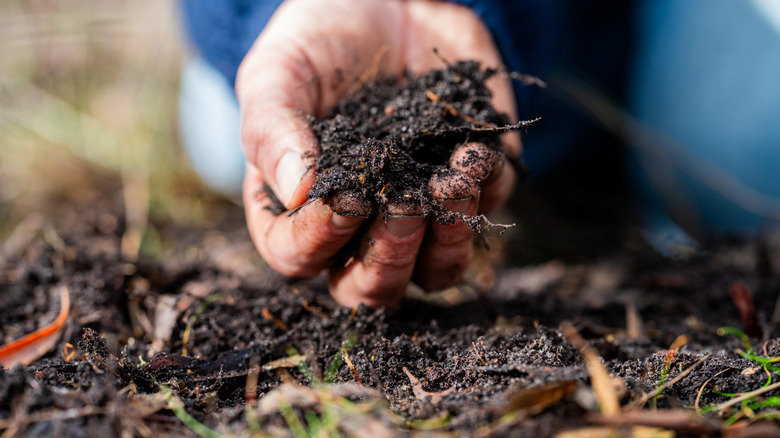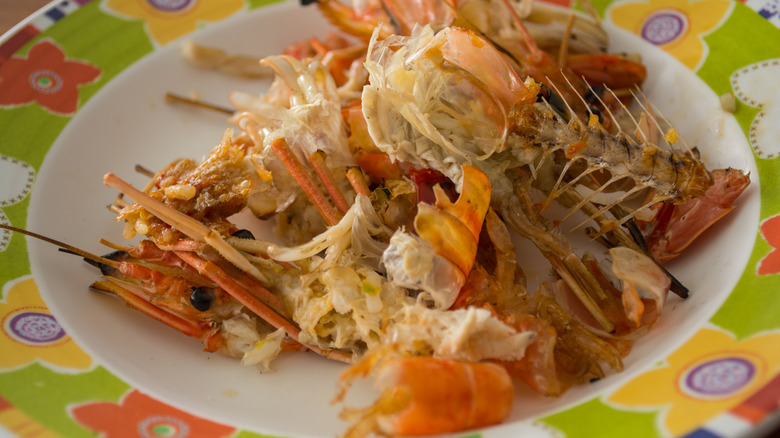Is Seafood Compost The Right Fertilizer For Your Garden? Here's What To Know
So many different types of kitchen scraps can be reused in your garden as a natural fertilizer, and seafood is one of the best. Seafood compost is an organic soil fertilizer that is made from processed shellfish, fish waste, and other marine byproducts combined with some classic compost materials like wood chips or straw. Unlike normal compost that relies on plant matter, seafood compost uses calcium-rich components like crab, shrimp, and lobster shells, along with nutrient-dense fish products that all break down into a natural fertilizer. The process can take several months and requires specific temperatures to help eliminate pathogens while preserving minerals and proteins.
Seafood compost has quite a few advantages for your garden soil. The crushed shells will slowly release calcium and micronutrients that improve the soil's structure over time. The fish parts help contribute nitrogen and phosphorus, both important components to a quality compost. Most commercial seafood composts will have a neutral to slightly alkaline pH, making it perfect for gardens with more acidic soil. There are a couple of downsides to the process, though. The strong ocean scent during initial decomposition makes this problematic for smaller areas or indoor composting. However, when made properly, seafood can be turned into some high-quality compost packed with minerals that support plant growth in ways that normal compost cannot.
How to use seafood compost in your garden
Knowing how much compost to add to your garden is important, and the unique composition of a seafood compost makes it great for heavy-feeder plants due to its slow-release of nitrogen and calcium content. As a general rule, you should always try to get a soil test done before using any additives to know exactly what your garden needs. For an already established garden, you'll want to begin by spreading a 2 to 4-inch layer of seafood compost across your garden bed during the early spring. Then incorporate it in with a garden fork. This makes sure that all the nutrients distribute evenly into the soil without clumping up too much in one area.
When planting vegetables, you can mix a handful of the compost directly into each planting hole. This will help the seedlings get an instant boost of nutrients. If you have potted plants, you can blend it with a standard potting mix, stick to a ratio of about 30% compost to 70% soil. This provides a good amount of nutrients while still allowing for proper drainage. For best results, use during the early spring or fall when plants do the most growing and avoid the extreme heat of summer, as it may not break down as efficiently.
Where to get seafood compost (& how to make your own)
Commercial seafood compost is available at some coastal garden centers and landscaping supply companies, particularly in regions with active fishing industries. Reputable brands offer bagged products that have been properly processed to eliminate pathogens and even help reduce salinity. When buying pre-made compost, look for certifications from the U.S. Composting Council and check that the product has a pleasant, earthy smell.
Making your own DIY compost isn't too difficult, and you can make seafood compost at home using crab shells, shrimp peels, or fish scraps from local markets. This does need a careful balance of one part seafood waste with three parts brown (dried leaves, wood chips) materials. Using a well-aerated compost bin, you'll want to maintain high temperatures of 130 to 150 degrees for several weeks to allow for proper breakdown and pathogen elimination. Bury any fresh fish scraps deep to help deter pests who might get a whiff of fresh food. You can also use the bokashi compost method, which will actually ferment the seafood waste before you mix it into the soil. However you choose to get it, a seafood compost can be a powerful nutrient-filled tool in your gardening arsenal.


